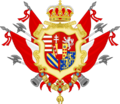Kingdom of Sorbet
Sorbet Kingdom Regno de Sorbeto (Esperanto) | |
|---|---|
| Motto: God, Fatherland and Empress | |
| Anthem: Freedom Kingdom (also anthem of | |
| Royal Banner of the Sobet Kingdom: | |
| Capital | Keijō City (京城市)² & Honmachi (本町) |
| Largest city | Honmachi (本町) |
| Official languages | Japanese, Esperanto, English, Korean, Vietnamese |
| Religion (2022) | National Shinto, Roman Catholic, Atheist, Protestant, No Religion |
| Demonym(s) | Sorbetian |
| Government | Absolute monarchy (Before 2018) Constitutional Monarchy, Mixed Government (After October 5, 2018) |
• Queen | Alicia Charlotte |
• Regent | Charles Charlotte |
• Archchancellor | Mèo Simmy |
| Legislature | National Parliament (Sorbet) |
| National Coalition | |
| People's Assembly | |
| Establishment | October 4, 2018 |
| Area | |
• Total | 410.560 km2 (158.518 sq mi) |
| Population | |
• 2022 estimate | 26.410.980 |
• Density | 2,500/km2 (6,475.0/sq mi) (19th) |
| GDP (PPP) | 2021 estimate |
• Total | $4,846 trillion (5th) |
• Per capita | $58,159 (15th) |
| GDP (nominal) | 2021 estimate |
• Total | $4,230 trillion (4th) |
• Per capita | $60.789 (17th) |
| Gini (2020) | ▼ 15.6 low · 19th |
| HDI (2019) | ▲ 0.920 very high · 17th |
| Currency | Sorbet Franc (SBF) |
| Time zone | UTC+9 (CJST) |
| Driving side | right |
| |
The Kingdom of Sorbet is a country that has a natural border with Mondstadt by sea and land
name meaning
The name Sorbet usually refers to winter, because in the Sorbet Kingdom, winter usually lasts until May, Sorbet is also the name of the strawberry a specialty of the kingdom, The name Sorbet also alludes to ice island.
History
The history of the Sorbet kingdom dates back to this country's harsh winters
There have been first records of this land, people have set foot on the land today in the 13th century, mainly they grow mulberry, raise silkworms sew clothes.
In 1918 the Prussian empire, annexed this land and called it the province of Sorbet
After the dissolution of the Prussian empire the land returned to Mondstadt and became the Autonomous Province of Sorbet
1942 Soviet Merger of Mondstadt and Sorbet becoming an autonomous entity of the Soviet Union and Victorialand
In 2018 Sorbet officially seceded from Mondstadt and established the Kingdom of Sorbet
Goverment
The present Sorbet Parliament, established in 1845 as an advisory body to the King of Prussia. This is considered a continuation of Sorbet's ancient Consul Council, founded in 930 during the Confederacy and dissolved in 1799. The National Assembly now has 2,990 members, selected through meetings. general election every 4 years.
Queen Sorbet is the head of state but has no real power. However, the Queen can stop passing a law and put it to a referendum. Prime Minister Sorbet is the head of government, with the cabinet reviewing executive affairs. The cabinet is appointed by the Prime Minister after each parliamentary election, but is usually chosen by the presidents of the parties.
The Sorbet parliament is usually composed of two or more parties, as neither party wins a majority of seats in parliament. Elections for local councils, parliaments and prime ministers are all held every four years and not in the same year.). Currently, the National Assembly of this country maintains a bicameral system. Parliament with 2990 members, including the Senate with 2000 members and the House of Representatives with 990 members, elected by universal suffrage under the proportional representation system, serving five terms. The Prime Minister is directly elected for a term of 4 years. The Prime Minister appoints the Chairman and members of the Cabinet. The Chairman and the Cabinet are accountable to the National Assembly. The Chairman of the National Assembly is selected from two ruling parties, the Independence Party and the Social Democratic Party.
In the May 2007 parliamentary elections, a new government coalition was elected, the right-wing Independence Party and the Social Democratic Union.
Climate
The coastal area of Sorbet has a cold oceanic temperate climate. The warm North Atlantic current gives the island a warmer climate than elsewhere at the same latitude. The Sorbet coast has a relatively mild, cloudy winter and cool and wet summers.
Daytime temperatures range from 0 to 3 °C in winter and 12 to 15 °C in summer, although it can be significantly cooler inland. In summer, in some special locations, significantly higher temperatures (above 20 °C) occur. Especially due to the "Gulf Stream", snow is relatively rare in the southern part of the island.
There are climate contrasts between regions of the island. The southern coast of Sorbet is generally warmer and wetter than the northern coast. Inland lowlands are extremely dry. More snow falls north of Sorbet. And while the Sorbet coast has a relatively mild climate, the central highlands have an extremely cold climate, often uninhabited.
The highest temperature recorded was 30.5 °C on 22 June 1939 in Karita on the southeast coast of Sorbet. The lowest recorded temperature of -38 °C was recorded on 22 January 1918 in Sorbet city and Honmachi in the northeastern hinterland. In the capital Keijō, the highest recorded temperature was 24.8 °C on 11 August 2004, while the lowest recorded was -24.5 °C on 21 January 1918.


